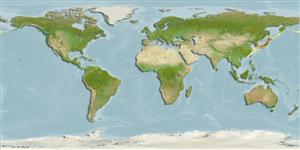Common names from other countries
Classification / Names
Common names | Synonyms | Catalog of Fishes(genus, species) | ITIS | CoL | WoRMS | Cloffa
Teleostei (teleosts) >
Perciformes/Cottoidei (Sculpins) >
Cottidae (Sculpins)
Etymology: Astrocottus: Greek, astra = ray + Greek, kottos = a fish (Ref. 45335); regulus: Name from Latin 'regulus' or regular, a common species collected frequently in northern Japan. It also is the name of the alpha star of the constellation Leo, which is connected with the genus name Astrocottus, meaning 'constellation sculpin'..
Environment: milieu / climate zone / depth range / distribution range
Ecology
Marine; demersal; depth range 10 - 55 m (Ref. 76844). Temperate
Northwest Pacific: Japan.
Size / Weight / Age
Maturity: Lm ? range ? - ? cm
Max length : 4.2 cm SL male/unsexed; (Ref. 76844)
Short description
Identification keys | Morphology | Morphometrics
Dorsal spines (total): 9 - 11; Dorsal soft rays (total): 13 - 15; Anal spines: 0; Anal soft rays: 13 - 14; Vertebrae: 32 - 34. This species possess the following characters: small head, its length 31-33% SL, depth 13-17% SL; flat and narrow interorbital space, its width 5.6-7.2% HL; basal length of anal fin 30-34% SL; scales on pectoral-fin rays and ventral surface of head and trunk absent; no nuchal cirrus; some scales below lateral line have filamentous cirri; D1 IX-XI (mode X); D2 13-15 (mode 14); A 13-14 (mode 14); lateral-line scales 31-33 (mode 32); vertebrae 12 + 20-22 (mode 12 + 21)=32- 34 (mode 33) (Ref. 76844).
Occurs on sandy and/or cobble bottom (Ref. 76844).
Life cycle and mating behavior
Maturities | Reproduction | Spawnings | Egg(s) | Fecundities | Larvae
Tsuruoka, O., S. Maruyama and M. Yabe, 2008. Revision of the Cottid Genus Astrocottus Bolin (Perciformes: Cattoidei), with the description of a new species from Northern Japan. Bull. Natl. Mus. Sci. Ser. A. Suppl. 2:25-37. (Ref. 76844)
IUCN Red List Status (Ref. 130435)
CITES (Ref. 128078)
Not Evaluated
Threat to humans
Harmless
Human uses
Tools
Special reports
Download XML
Internet sources
Estimates based on models
Phylogenetic diversity index (Ref.
82804): PD
50 = 0.5625 [Uniqueness, from 0.5 = low to 2.0 = high].
Bayesian length-weight: a=0.00676 (0.00300 - 0.01523), b=3.17 (2.98 - 3.36), in cm Total Length, based on LWR estimates for this (Sub)family-body shape (Ref.
93245).
Trophic level (Ref.
69278): 3.2 ±0.4 se; based on size and trophs of closest relatives
Resilience (Ref.
120179): High, minimum population doubling time less than 15 months (Preliminary K or Fecundity.).
Fishing Vulnerability (Ref.
59153): Low vulnerability (10 of 100).
